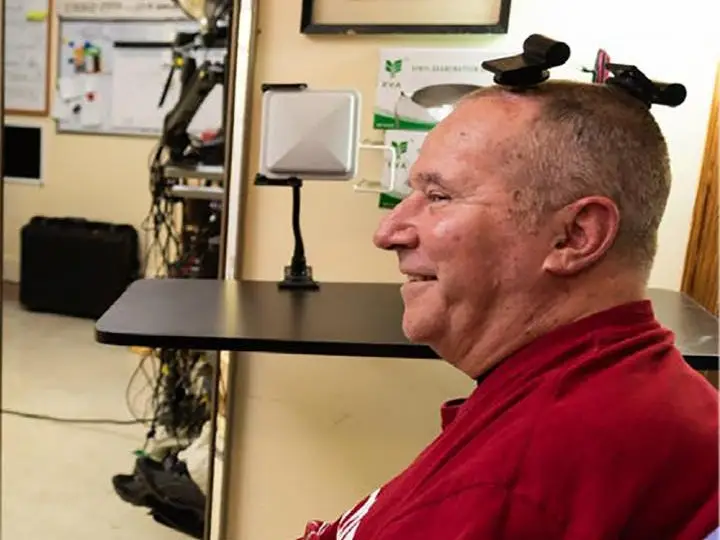The future of neuroscience could be wireless

This article is part of “5G and Connectivity Playbook,” a series exploring some of our time’s most important tech innovations.
In March 2020, Dr. Leigh Hochberg and his colleagues realized two alarming realities: The pandemic was spreading, and clinical research would shut down rapidly.
Hochberg, a Brown University professor, is the director of BrainGate clinical trials. This expansive, multi-institution research program develops and tests brain-computer interface technologies designed to help people who have lost the ability to speak or move — such as translating the brain activity of ALS patients into words on a computer screen and helping paralyzed people move robotic arms with their minds.
Before COVID-19, a wireless version of the system had only been tested with a researcher in the room. Its full potential — and ability to work smoothly without a medical professional on standby — had not been evaluated.
When in-person clinical research stopped due to the pandemic, the team decided to teach the participants’ caregivers how to establish the wireless connection and proceed with the project.
Hochberg said the moment felt like fate.
“As the world started to shut down, we realized that if we acted quickly, we had an opportunity to continue with our research,” he said. “The wireless technology allowed our participants to remain engaged in the trial and allowed us to record overnight for the first time.”
Though Elon Musk’s Neuralink put wireless brain implants in the spotlight — in early 2024, Musk announced his company’s first implant was successful — the research and development of these devices has spanned decades. The BrainGate clinical trials have been underway for 20 years, and the consortium’s wireless implant marks the first time a person has used an implant with high bandwidth capabilities.
Wireless technologies are opening doors in neuroscience, enabling new capabilities in communication, treatment, and research. Because wireless implants can monitor the brain for long periods of time, they offer a unique opportunity to examine neural dynamics, increasing our understanding of the human mind. Their cord-free design also benefits people hoping to use these devices outside a research setting and improve their quality of life.
Powering a new model of connectivity
The first brain implant is credited to neurologist Phil Kennedy, who had the device surgically affixed to his brain. Today, wired implants are less invasive and widely used. They can help prevent seizures, manage OCD symptoms, and treat movement disorders.
Researchers are improving brain implant devices with wireless technology. These devices can transmit information without cables through radio frequency fields, acoustic waves, and light.
For the first decade of BrainGate trials, the system — electrodes implanted in the brain that record neural activity and computers that simultaneously decode those brain signals — required a cable connection between the implant and the computers. This meant participants were physically tethered to the equipment. “It was very clear early on during the clinical trials that we all looked forward to a day where there would be a wireless system,” Hochberg said.
That day came in the late 2010s when the BrainGate team started to use a small, wireless neural transmitter developed by Brown University researchers. When placed on a user’s head, the transmitter connects to the implant in the brain’s motor cortex through a port on the skull. The transmitter then sends the information to a computer system to be analyzed.
“To put something in someone’s brain is a very high bar,” Jordan McCall, a neuroscientist and an associate professor at the Washington University School of Medicine in St. Louis School, told B-17. He works on creating wireless brain-interfacing devices that are small, flexible, and biocompatible.
In 2021, McCall and his colleagues published a paper in Nature Biomedical Engineering showing how they could remotely alter neural activity in rat brains using a wireless brain implant. With the help of Internet of Things technology, the implant included a Bluetooth microchip and a laser supported by Raspberry Pi, a small, single-board computer.
McCall said the use of store-bought technology was intentional. The goal, he added, was to make devices that are accessible to the scientific community.
However, wireless brain devices are still a work in progress. Some of the hurdles include long-term compatibility with brains, the reliability of wireless communication, and balancing data transmission quality with power consumption. But McCall said we’re at a moment when there’s plenty of space for new technologies to emerge.
“We’re definitely not done, but I no longer think we’re at the beginning of this,” he said.
Exploring the brain cord-free
In addition to being an assistive technology, wireless implants are also valuable research tools.
Philipp Gutruf, an associate professor of biomedical engineering at the University of Arizona, told B-17 that the information gained through wireless devices could help researchers better understand human behavior and develop improved treatments for conditions like addiction. Gutruf develops devices intended to improve how medical conditions are diagnosed and treated and increase our understanding of the brain.
“The brain is incredibly complex, and we’ve been trying for a long time to decipher how the brain works and operates,” Gutruf said.
Much of the field has focused on deciphering the electrical signals the brain constantly produces. However, the brain also contains chemicals such as dopamine that influence our mood and health. How these factors affect the brain is less understood, and Gutruf and his team are investigating this side of the equation.
They developed a wireless, battery-free implant that can monitor dopamine signals in the brain. The device uses a technique called optogenetic stimulation to activate or inhibit certain neurons in mice and record dopamine activity.

BrainGate system with a cable (left)

Wireless BrainGate system (right)
“We created a system that allows us to look at the brain in action while the animal subjects behave naturally,” Gutruf said. “This is proving ground for a new type of technology that may lead to human application later.”
The implant is powered remotely and transmits data wirelessly using infrared light waves. In other experiments, Gutruf and colleagues have also used near-field communication, a wireless technology commonly used for contactless payment systems or keyless entry. With near-field communication, data is transmitted through electromagnetic radio fields.
A better understanding of neurochemical composition in the brain could lead to earlier detection of neurodegenerative diseases like Parkinson’s, as well as personalized therapies for mental and behavioral disorders.
“Right now, we have a reasonable grasp of the rest of the body, but the brain still has mysteries to unravel,” Gutruf said. “New tools allow us to see what’s going on in the brain in real time, which may allow us to decipher some of these mysteries.”
Wireless tech’s potential
While brain implants aren’t new, McCall said that about a decade ago, there was an “exponential shift in what was possible.” Advancements in material science and electrical engineering, along with the financial backing of the National Institutes of Health BRAIN Initiative, which kicked off in 2013, helped accelerate the technology significantly, leading to the current effort to optimize wireless brain implants.
Hochberg said academic institutions and private companies are racing to develop different versions of wireless devices.
But when it comes to implants designed for clinical purposes — like helping a patient express a thought — Hochberg said there are still questions about obtaining the tech outside a research setting. He is part of the Implantable BCI Collaborative Community, a newly launched project where neurotechnology stakeholders can discuss such challenges. The hope is to lay the groundwork for a more accessible future.
Hochberg is excited about BrainGate’s potential to decode attempted speech instantly and synch it with wearable soft robotics, allowing for more comfortable and intuitive movements.
“There is tremendous promise for this powerful technology,” Hochberg said.






